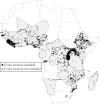Organized Violence and Institutional Child Delivery: Micro-Level Evidence From Sub-Saharan Africa, 1989-2014
- PMID: 29949085
- PMCID: PMC6060989
- DOI: 10.1007/s13524-018-0685-4
Organized Violence and Institutional Child Delivery: Micro-Level Evidence From Sub-Saharan Africa, 1989-2014
Abstract
The conditions under which a mother gives birth greatly affect the health risk of both the mother and the child. This article addresses how local exposure to organized violence affects whether women give birth in a health facility. We combine geocoded data on violent events from the Uppsala Conflict Data Program with georeferenced survey data on the use of maternal health care services from the Demographic and Health Surveys. Our sample covers 569,201 births by 390,574 mothers in 31 countries in sub-Saharan Africa. We use a mother fixed-effects analysis to estimate the effect of recent organized violence events within a radius of 50 km of the home of each mother on the likelihood that her child is born in a health facility. The results indicate that geographical and temporal proximity to organized violence significantly reduces the likelihood of institutional births. Although the level of maternal health care overall is lower in rural areas, the negative effect of violence appears to be stronger in urban areas. The study further underscores the importance of household and individual resilience, indicating that the effect of organized violence on institutional child delivery is greater among poor and less-educated mothers.
Keywords: Armed conflict; Demographic and Health Surveys; Maternal health; Organized violence; Sub-Saharan Africa.
Figures




Similar articles
-
Armed conflict and maternal mortality: A micro-level analysis of sub-Saharan Africa, 1989-2013.Soc Sci Med. 2019 Oct;239:112526. doi: 10.1016/j.socscimed.2019.112526. Epub 2019 Sep 5. Soc Sci Med. 2019. PMID: 31520880
-
Examining the relationship between armed conflict and coverage of maternal and child health services in 35 countries in sub-Saharan Africa: a geospatial analysis.Lancet Glob Health. 2023 Jun;11(6):e843-e853. doi: 10.1016/S2214-109X(23)00152-3. Lancet Glob Health. 2023. PMID: 37202021
-
Antenatal care and women's birthing decisions in an Indonesian setting: does location matter?Rural Remote Health. 2015 Apr-Jun;15(2):2959. Epub 2015 Jun 8. Rural Remote Health. 2015. PMID: 26066607
-
Armed violent conflict and healthcare-seeking behavior for maternal and child health in sub-Saharan Africa: A systematic review.PLoS One. 2025 Feb 4;20(2):e0317094. doi: 10.1371/journal.pone.0317094. eCollection 2025. PLoS One. 2025. PMID: 39903770 Free PMC article.
-
Coverage of intermittent preventive treatment and insecticide-treated nets for the control of malaria during pregnancy in sub-Saharan Africa: a synthesis and meta-analysis of national survey data, 2009-11.Lancet Infect Dis. 2013 Dec;13(12):1029-42. doi: 10.1016/S1473-3099(13)70199-3. Epub 2013 Sep 18. Lancet Infect Dis. 2013. PMID: 24054085 Review.
Cited by
-
Effects of terrorist attacks on access to maternal healthcare services: a national longitudinal study in Burkina Faso.BMJ Glob Health. 2020 Sep;5(9):e002879. doi: 10.1136/bmjgh-2020-002879. BMJ Glob Health. 2020. PMID: 32978211 Free PMC article.
-
Area level indirect exposure to extended conflicts and early childhood anthropometric outcomes in India: a repeat cross-sectional analysis.Confl Health. 2023 May 7;17(1):23. doi: 10.1186/s13031-023-00519-8. Confl Health. 2023. PMID: 37150814 Free PMC article.
-
Women and children living in areas of armed conflict in Africa: a geospatial analysis of mortality and orphanhood.Lancet Glob Health. 2019 Dec;7(12):e1622-e1631. doi: 10.1016/S2214-109X(19)30407-3. Epub 2019 Oct 24. Lancet Glob Health. 2019. PMID: 31669039 Free PMC article.
-
The Consequences of the Tajikistani Civil War for Abortion and Miscarriage.Popul Res Policy Rev. 2021 Oct;40(5):1061-1084. doi: 10.1007/s11113-020-09624-5. Epub 2020 Oct 27. Popul Res Policy Rev. 2021. PMID: 34658465 Free PMC article.
-
Women, children and adolescents in conflict countries: an assessment of inequalities in intervention coverage and survival.BMJ Glob Health. 2020 Jan 26;5(1):e002214. doi: 10.1136/bmjgh-2019-002214. eCollection 2020. BMJ Glob Health. 2020. PMID: 32133179 Free PMC article.
References
-
- Al Gasseer, N., Dredsen, E., Brumbaugh, G., & Warren, N. (2004). Status of women and infants in complex humanitarian emergencies. Journal of Midwifery & Woman’s Health, 49(Suppl. 1), 7–13. - PubMed
-
- Bell, J., Curtis, S. L., & Alayon, S. (2003). Trends in delivery care in six countries (DHS Analytical Studies No. 7). Calverton, MD: ORC Macro and International Research Partnership for Skilled Attendance for Everyone (SAFE).
Publication types
MeSH terms
LinkOut - more resources
Full Text Sources
Other Literature Sources

